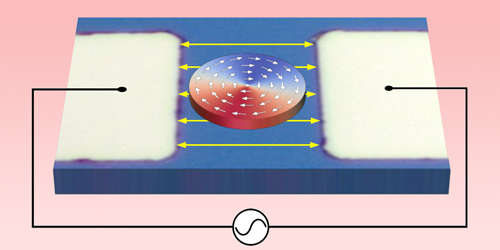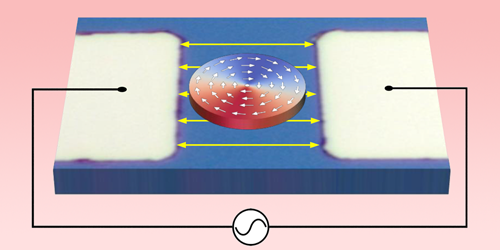Magnetic Gyrations Are Excited by Strain
Nanoscopic magnetic vortices made from electron spins could be used in spintronic computers (see Research News: 3D Magnetism Maps Reveal Exotic Topologies). To this end, researchers need an energy-efficient way to excite these vortices into a so-called gyrotropic mode—an orbital motion of the vortex core around the central point. The direction of this orbital motion would determine which of two binary states the vortex represents. Vadym Iurchuk at the Helmholtz-Zentrum Dresden-Rossendorf, Germany, and his colleagues have now demonstrated such a method by imposing a time-varying strain on a magnetic material [1].
The excitation of gyration dynamics by an oscillating strain was suggested by a separate team in 2015 [2]. The idea involves depositing a magnetic film, in which magnetic vortices form spontaneously, on a piezoelectric substrate. Applying an alternating voltage to the substrate transfers a time-varying mechanical strain to the film, dynamically perturbing its magnetic texture. This perturbation displaces a vortex core from its equilibrium position, thereby exciting the gyrotropic mode.
Iurchuk and his colleagues realized this approach using a disk of cobalt iron boron several micrometers across. They examined the disk’s vortex dynamics by measuring its magnetoresistance, which should oscillate when the gyrotropic mode is present. First, they injected a spin-polarized radio-frequency current into the disk without driving the underlying piezoelectric layer. This current excited the gyrotropic mode and was used to measure the dynamic magnetoresistance that resulted. The magnetoresistance signal peaked when the frequency was resonant with the vortex core’s orbital motion. Then, keeping the frequency of the injected current below this value, the researchers stimulated the piezoelectric substrate at the resonant frequency. By measuring the same magnetoresistance signal, they showed that the gyrotropic mode had been excited by the resonant mechanical strain.
Iurchuk and colleagues say that their approach offers an extra degree of freedom for exciting and manipulating magnetic vortices while significantly reducing the energy requirements compared to existing methods.
–Rachel Berkowitz
Rachel Berkowitz is a Corresponding Editor for Physics Magazine based in Vancouver, Canada.
References
- V. Iurchuk et al., “Excitation of the gyrotropic mode in a magnetic vortex by time-varying strain,” Phys. Rev. Lett. 133, 146701 (2024).
- T. A. Ostler et al., “Strain induced vortex core switching in planar magnetostrictive nanostructures,” Phys. Rev. Lett. 115, 067202 (2015).





